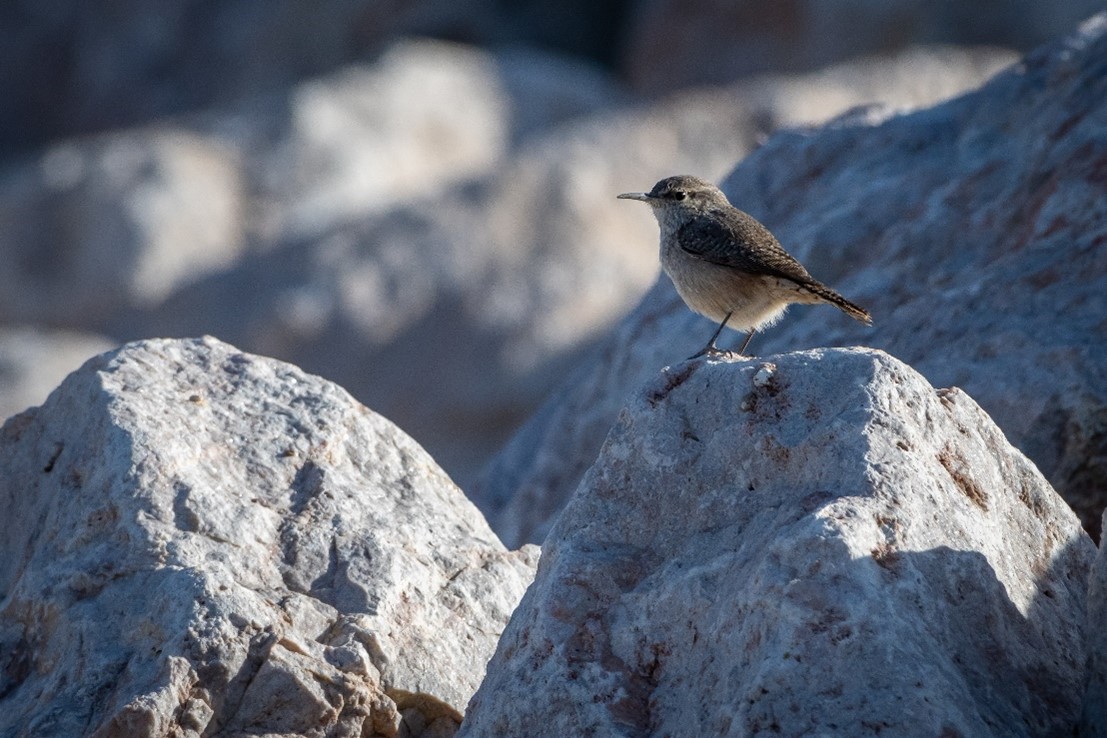The Rock Wren

WHICH WETLANDS PARK BIRD IS A TRUE ARTISAN?
Rock wrens (Salpinctes obsoletus) are common resident birds at Clark County Wetlands Park and yet, I would bet most visitors seldom see them! Like other members of the wren family (Troglodytidae – Greek for “cave dweller”), they are active yet secretive birds. With their quiet brown plumage, relatively small size – just smaller than song sparrows at 6” long – and habit of feeding on the ground or in low vegetation, they can easily be overlooked.
But keeping on the watch for these interesting wrens and listening for their vibrant, buzzing song can bring the reward of observing the capture of an insect or spider among rocks or bushes, or a view of the trademark “wren” flip of the tail above the back (called “cocking”). Rock wrens will also perform sets of their characteristic bouncing “deep knee bends” accompanied by ringing calls from rock tops when excited. One of the best places in the Park to see the show is at Wells Trailhead, so a breakfast or lunch break there could be an excellent plan!
Rock wrens have one of the largest breeding ranges of any North American bird, nesting from British Columbia in Canada south to northern Mexico, and from western Nebraska to the Pacific Ocean. American biologist Edmund C. Jaeger says the birds may nest anywhere rocky ledges, piles of boulders, talus slopes, or shale slabs offer small “cavelets, crypts, and crevices in which the nest may be safely hidden.” The birds appear to get most of their moisture from the insects and spiders they feed on, so dry desert areas are fine with them!
Some rock wren nests are located in crevices as much as fifty feet up on vertical surfaces, while others are built in rock covers at ground level. Rock wrens are excellent stone masons, building dry masonry retaining walls in front of the nest, leaving just enough room for the adults to squeeze in. The walls require carrying a lot of small, flat rock chips up to an inch and a half long to the building site, then placing them with care to form the wall. As part of the construction project, the birds also create a “porch” or paved pathway near the entrance to the nest. These flat rock “pavements” look almost like scatters of pottery shards and are often the only sign that a nest is in the area. Since rock wrens often repair and reuse the same nesting site season after season, the rock scatters may get substantial. One was counted at 750 pieces of flat caliche!
Like many construction workers, the rock wren begins its daily activity early in the morning, often in near-darkness and before many other bird species. It is also often the last bird active as the sun begins to set. The wren’s “early-bird” habit once helped my archaeologist husband Bob on a project. He was recording a site with a rock shelter in it and wondered where the water source for the obviously permanently occupied site could be since there was no spring nearby. Early one morning, the rock wrens gave Bob a clue. Just before sunrise, he saw the wrens clinging to the near-vertical rocks above his campsite, pecking away busily. The next morning, he climbed up to see what they were up to. He found that the rocks were damp! The seep produced enough water for the little birds, but only before the sun dried the rocks each morning. Bob deduced: maybe the climate was wetter when people lived in the rock shelters and the seep was a spring with enough water for them. Thank you, rock wrens!
Please enjoy these YouTube videos!
Rock Wren (Salpinctes obsoletus) Searching for Insects Lake Balmorhea
60 Seconds with Rock Wrens Singing
How Many Rock Wren Babies in This Video?
– By Chris Leavitt, President; photo by David Walker
